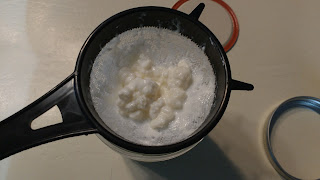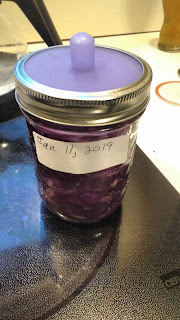For my second food ferment, I am trying to make red sauerkraut. This is the first recipe in the book that came with the fermentation kit. The book is also available
online. I chose red cabbage, because I find it has more flavor than green cabbage.
As with the Dilly Sticks, the recipe is for a quart mason jar, and I am using pint jars. The first ingredient is one small red or green cabbage (about 2 pounds). I can't buy half a head of cabbage, but had some other ideas to cook the leftovers. I quartered and shredded half of the cabbage after saving one leaf that is used as a top layer later on.
I'm next instructed to add the cabbage to a large bowl in layers with salt in between. The bowl I used is about 9 inches in diameter and about 2-3 inches deep. Keep in mind that this is just one half of a cabbage. Working with the whole thing would, indeed, take a "large bowl."
Next, we massage and squeeze the cabbage by hand and then pound it flat with the Pickle Packer (included in the fermentation kit from Masontops.) Well, a round-bottomed bowl is not the right vessel for this step. The cabbage keeps spilling out the sides of the bowl, and there is not a lot of flat surface on the bottom to pound it flat against.
I switched to a casserole dish with much better results.
Now, it's time to pack the jar. I'm instructed to fill and pack the jar until it reaches the shoulder of the jar. The pint jars, don't really have a shoulder. I can sort of estimate where that would be compared to a picture of a quart jar in the guide book.
To my surprise, the half a cabbage doesn't come close to filling a one pint jar. Maybe I shouldn't be surprised. The recipe suggested that a 2 pound cabbage almost exactly fills a quart jar. My cabbage weighed in at 26 ounces. Maybe in the future I will weigh out 1 pound of cabbage to work with.
I shredded, pounded, and packed another quarter of the cabbage and had a little left over.
Next, I'm told to take the cabbage leaf that I saved from the first step, set it on the cutting board and, "Set the jar on the leaf, near the top where it is more pliable." The jar is pliable? If you were an English major in college, please leave a comment. This sentence had me confused, at first.
The idea is to cut a circle from the cabbage leaf that matches the inside diameter of the jar. It seems to me that using the mason jar ring is an easier method. That's what I did.
Now, we put a Pickle Pebble weight on top of the cabbage leaf, and a Pickle Pipe for ventilation and set it on a shelf to ferment. It is supposed to be ready in 2-3 weeks, or maybe a month or more, depending on the ambient temperature.
I'm supposed to wait a day or two to check the progress. If the cabbage and Pickle Pebble is not submerged in liquid after a couple of days, I'm supposed to add some brine. I found that my liquid level was all the way up to the surface of the Pickle Pipe. Maybe I overfilled the jar to start with. I poured off a tablespoon or so of the liquid and put the Pickle Pipe and ring back on.
Everything seems to be off to a good start. We'll check back around the end of January. Cue Tom Petty, "The Waiting is the Hardest Part."
Update: Another day later, and the Pickle Pipe is bulging upward. That's a good sign that fermentation is happening, but some of the purple brine is leaking out, too. I poured off another 1/2 inch or so of the brine to give it some head room. I definitely over filled the jar to start.
Update:
The harvest was successful. I tried the kraut after about 3 weeks. It has the pleasant sour flavor that I would expect. It is a little dry. There is hardly any juice in the jar. It's still slightly moist after digging through the top half inch, but there is no fluid that could be poured off. Next time I will need to use a little less cabbage.
I've been eating it raw. Cooking will kill off the beneficial bacteria that I have been trying to cultivate. I might try cooking with it eventually, but for now it is just an attractive side dish to a meal.
Second Batch:
For my second batch, I planned from the start to use 3/4 of a red cabbage. The whole cabbage weighed about 1-1/4 pounds. My three quarters weighed a little less than one pound. It fit perfectly into a pint jar. After packing, the liquid came up to the 10 ounce mark on the jar.
With the Pickle Pebble in place, there is still some head room.
I'll check in a couple of days to see if it is overflowing like it did before. A more precise fill mark should help with future batches.
Update: After three days, there was some overflow, so the 10 ounce marks is a little too high. The Pickle Pebble was all the way to the top of the jar. Last time, I poured off some of the liquid, and the sauerkraut came out rather dry. This time, I took out a pinch of the kraut (about 1 tablespoon) and ate it. It's not too bad after just 3 days. I don't think I'm going to wait a month to harvest this batch. Advice I've read suggests that I should taste it to decide when it is done.
I added some dill and caraway seeds to this batch to enhance the flavor. Those spices were suggested by the recipe. I didn't measure the amount, but estimated it at about 1/2 teaspoon of each. I also didn't measure the salt. The recipe calls for 1/2 tablespoon for a one-pint batch. I used two generous pinches after each quarter cabbage.




































